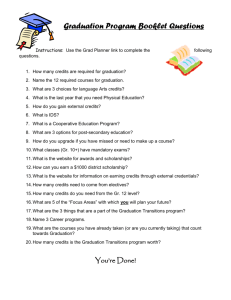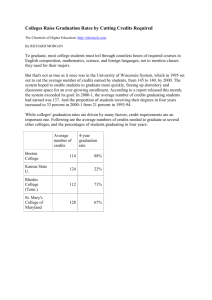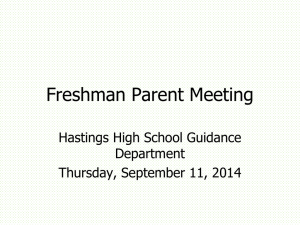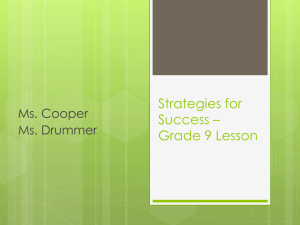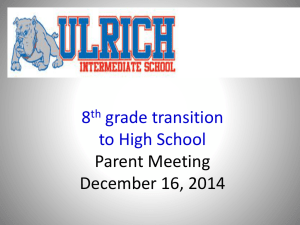Expansion of the School Year and Summer Transition Programs
advertisement
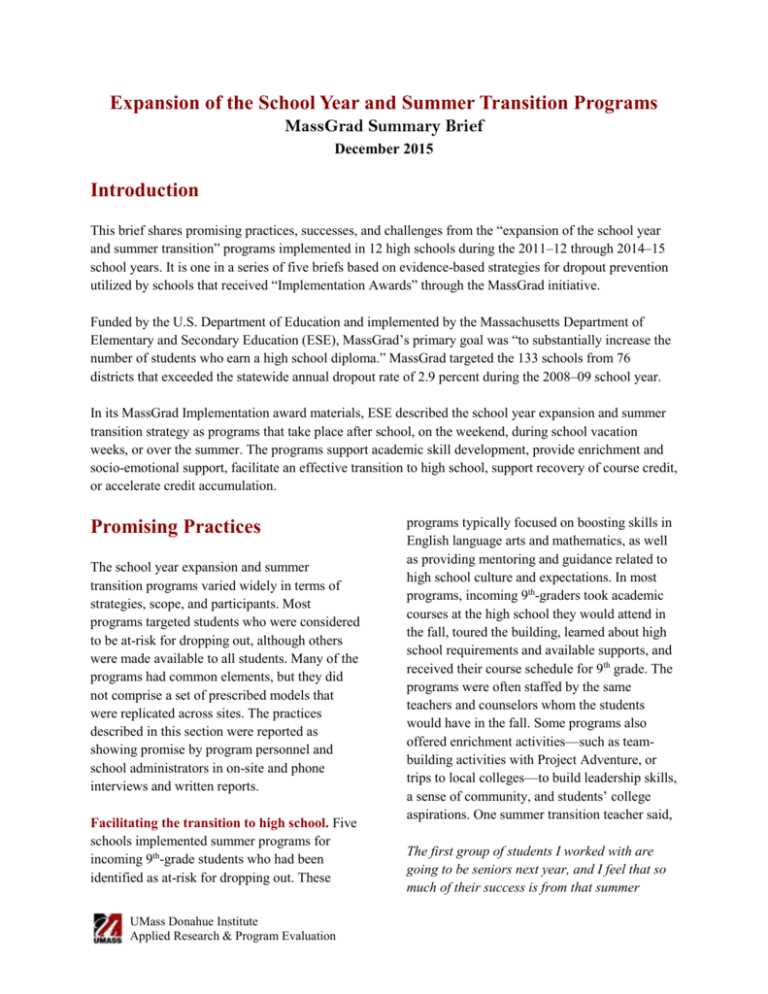
Expansion of the School Year and Summer Transition Programs MassGrad Summary Brief December 2015 Introduction This brief shares promising practices, successes, and challenges from the “expansion of the school year and summer transition” programs implemented in 12 high schools during the 2011–12 through 2014–15 school years. It is one in a series of five briefs based on evidence-based strategies for dropout prevention utilized by schools that received “Implementation Awards” through the MassGrad initiative. Funded by the U.S. Department of Education and implemented by the Massachusetts Department of Elementary and Secondary Education (ESE), MassGrad’s primary goal was “to substantially increase the number of students who earn a high school diploma.” MassGrad targeted the 133 schools from 76 districts that exceeded the statewide annual dropout rate of 2.9 percent during the 2008–09 school year. In its MassGrad Implementation award materials, ESE described the school year expansion and summer transition strategy as programs that take place after school, on the weekend, during school vacation weeks, or over the summer. The programs support academic skill development, provide enrichment and socio-emotional support, facilitate an effective transition to high school, support recovery of course credit, or accelerate credit accumulation. Promising Practices The school year expansion and summer transition programs varied widely in terms of strategies, scope, and participants. Most programs targeted students who were considered to be at-risk for dropping out, although others were made available to all students. Many of the programs had common elements, but they did not comprise a set of prescribed models that were replicated across sites. The practices described in this section were reported as showing promise by program personnel and school administrators in on-site and phone interviews and written reports. Facilitating the transition to high school. Five schools implemented summer programs for incoming 9th-grade students who had been identified as at-risk for dropping out. These UMass Donahue Institute Applied Research & Program Evaluation programs typically focused on boosting skills in English language arts and mathematics, as well as providing mentoring and guidance related to high school culture and expectations. In most programs, incoming 9th-graders took academic courses at the high school they would attend in the fall, toured the building, learned about high school requirements and available supports, and received their course schedule for 9th grade. The programs were often staffed by the same teachers and counselors whom the students would have in the fall. Some programs also offered enrichment activities—such as teambuilding activities with Project Adventure, or trips to local colleges—to build leadership skills, a sense of community, and students’ college aspirations. One summer transition teacher said, The first group of students I worked with are going to be seniors next year, and I feel that so much of their success is from that summer program … Our students develop relationships with people, and that’s what keeps them here, and that’s what they’re looking for. Between the program and the graduation coaches, that’s what helps those kids be successful. That’s what’s permanent in their life. While these programs were typically offered only to at-risk students, one district removed that requirement in response to students who were ineligible but wanted the same opportunities to tour the school, receive their class schedule, make new friends, and feel more confident about entering 9th grade. Providing enrichment opportunities. Several schools offered enrichment activities, either as a stand-alone program or to complement an academically-focused program. These activities included college visits, experiential learning, and career exploration. Some schools provided core or elective credit for the programs in which the enrichment activities were embedded. One school that implemented summer enrichment activities targeted at-risk students in 9th and 10th grade, but any student in those grades could participate. The program focused on building students’ leadership skills and increasing their interest in and motivation to attend college. Students participated in Project Adventure and visited local colleges and historical sites. One school partnered with an outdoor adventure program to provide experiential-learning opportunities, and also offered a film-making project. Another school offered a six-week summer program that served over-aged and under-credited students. In addition to its academic curriculum, the program took a weekly field trip and offered a 30-hour sailing trip during which students learned to sail, studied nautical history, and carried out academic activities related to the ocean. Offering a summer semester. One school offered a “fourth semester,” in which students took one to two summer courses in order to accelerate their graduation date or recover credits needed to graduate on time. Courses in English language arts, mathematics, and science were offered for two hours per day, five days per week for four weeks. These courses offered credit equivalent to taking the same course during the school year. The fourth semester also included enrichment activities based on student interests. For example, the school offered a gardening club one summer that was well attended. As part of this program, the school was trying to change students’ perception that summer school is only for students who need to recover credits from classes they had failed. The school was also promoting the opportunity to take additional courses in order to graduate sooner. Each year, the site attempted to make that option more appealing to students by expanding the summer courses offered. When students expressed interest in incorporating summer courses into their annual course-taking plans, the school began telling them in the fall what courses would be offered the following summer. Providing after-school academic support. One school provided an after-school study club for 9th- and 10th-grade students that took place four afternoons per week. Initially, the club only served students who were failing one or more classes, but other students also wanted to participate, and the program had capacity to expand, so it was opened to all 9th- and 10thgrade students. More details of this program are provided in the Spotlight section about Charlestown High School. 2 Offering online credit recovery. Two schools offered online courses after school for students who needed to recover credits. Students worked in a computer lab, with a teacher available to provide academic support and manage the courseware. Attendance problems led both schools to implement minimum attendance requirements. For example, one school required students to attend for at least two hours per week. A recent publication from the MassGrad evaluation provides more detailed promising practices for teachers of online credit recovery courses.1 Offering traditional credit recovery. Two schools offered traditional, teacher-led (as opposed to online) after-school credit recovery programs. One of the schools created an alternative learning academy where 9th- through 12th-grade students could recover up to two courses in the spring. The courses were offered on weekdays from 3:30–6:00 p.m. for eight weeks, with one course offered on Mondays and Wednesdays and the other on Tuesdays and Thursdays. The second school launched a district-wide “Graduation Academy” for 12th-grade students who had failed one or two core academic courses that would prevent them from graduating on time. The courses were offered in the spring, with scheduling similar to the alternative learning academy just described. In addition to increasing the number of students graduating on time, the credit recovery capacity provided by the Graduation Academy reduced the number of seniors taking summer school courses. This increased the summer school seats available for students in other grades. “Online courses for credit recovery: Promising practices for high school teachers.” http://www.nmefoundation.org/resources/studentcentered-learning/online-courses-for-credit-recoverypromising-pract. 1 Two schools also offered summer credit recovery programs for required English and mathematics courses, as well as some history, science, and world language courses. The program at one school was 22 days long, 4 days per week, from late June until early August. It took place from 8:00 a.m. until 1:00 p.m. and included breakfast and lunch. Students could enroll in up to two courses. Students who were absent for more than two days were required to have a medical excuse or were dismissed from the program. Supporting English language learners. One school offered a summer program for 200 English language learners who scored at the lowest levels on the state’s ACCESS for ELLs assessment. Staff reported that they spoke in English at all times, and students were expected to do the same. The students completed academic courses and participated in art and dance activities, college visits, and field trips that exposed them to American culture. Providing work-based learning opportunities. One school offered summer work-based learning opportunities, mostly within the district, in which students worked Monday through Thursday in paid placements within the schools and in the community. Their work included screen printing, mural painting, cooking, teaching, and other positions. On Fridays they participated in online academic work intended to improve MCAS math and writing performance. During the school year, the school ran an afterschool program similar to the summer program. Students worked in paid positions within the schools from two to eight hours per week. Leveraging roles and relationships. As already noted, school personnel believed that positive relationships with adults increased students’ attendance and engagement. Some staff reported leveraging the relationships they had developed 3 with students during expanded school year programs by continuing to check in with the students during regular school hours. They also reported that some students actively sought out program personnel for support and connection during the regular school hours. One summer program administrator said, The kids like being here. They come for the social aspect. They come to get a meal. They enjoyed developing a video game. It helps kids who are having troubles, like when their family is going into a homeless shelter. It helps kids learn how to open up to adults and let them know what’s going on in their life. One of the other MassGrad Implementation Award strategies was “Adult Advocates for Student Support” (e.g., graduation and reengagement coaches), and the adult advocates at some sites checked in and worked with students in their caseload during after-school and summer programs. One school did this in the opposite order, using their relationships from a summer program to identify students who needed graduation coaches. They did this by hosting an event with their summer students on the day that first-quarter report cards were distributed— having pizza together and checking the report cards for students who were struggling academically. Finally, some sites utilized peer relationships by enlisting students who had previously participated in the program as mentors for new participants. Successes and Challenges Many successes and challenges are embedded in the promising practices and program spotlight sections of this summary brief. Additional successes and challenges are introduced in this section. After multiple years of implementing school year expansion and summer transition programs, schools reported that participating students were less likely to drop out of high school and commit disciplinary infractions, and their attendance improved. Students who participated in 9th-grade transition programs were reportedly more likely to be promoted to 10th grade, form strong relationships with teachers, and transition to high school with fewer academic, behavioral, and attendance problems. Students who participated in credit recovery programs were often able to recover the credit needed to be promoted to the next grade level or to graduate on time. School personnel reported that many of the programs boosted students’ confidence and motivation. These qualities were addressed explicitly by enrichment activities that focused on students’ leadership skills, team-building skills, or college aspirations. They were also addressed informally by programs that provided one-on-one or small group support by staff or peer mentors, such as homework club or an online credit recovery lab. The personalized learning provided by these programs helped students build academic and study skills that led to greater academic success, which in turn increased student confidence, engagement, and motivation for additional success. Despite improvements in attendance for some program participants, student absenteeism remained a challenge for the school year expansion and high school transition programs. Strategies that programs used to improve student attendance were described above. Another challenge reported by several sites was recruitment of staff and students. Some sites reported a shortage of available staff from within the school, many of whom did not want to take on additional duties or were already engaged in after-school and/or summer activities. As a 4 result, some summer programs moved their staff selection process to earlier in the school year, beginning recruitment as early as January. Student recruitment relied on year-end grades, but grades were typically unavailable until just days before summer programs were scheduled to begin. Some schools addressed this challenge by identifying students whose grades late in the year indicated that they were likely to need summer credit recovery, notifying them before final grades were posted, and encouraging them to pre-register. Once grades became available, students who did not need to participate were notified. To identify incoming 9th graders for summer transition programs, some sites utilized the state’s Early Warning Indicator System (EWIS). The school year expansion programs primarily targeted students who were at risk of being retained or dropping out. Program staff reported that many of these students were frequently absent and reluctant to spend extra hours at school during the school year or summer. Programs addressed this challenge through policies, outreach, culture, and incentives. Several programs had policies that students who exceeded a specified number of unexcused absences, typically two or three, would be dismissed from the program. Some sites did not adhere to these policies strictly, which they said would have resulted in an unacceptable level of dismissals. However, they believed that the policies were effective for some students. Many sites also contacted students who had been absent in order to encourage them to return to the program. One site used a contract with students and their parents or guardians in order to communicate and encourage adherence to program policies. With regard to culture, some school staff attempted to dispel student perceptions that these programs were punitive. Instead, they framed the programs as opportunities that students were fortunate to have available. Staff also strived to develop positive relationships with students in order to strengthen their motivation to continue attending. Some programs invited students to share what they liked about the program and what could be improved. Finally, many programs offered snacks, meals, and/or transportation to and from the program. Course credits also served as a key motivation for student attendance. Several programs offered credits in English or mathematics to incoming 9th graders for completing summer transition programs. Many students did not need to use those credits, but program staff explained that the credits served as a “safety net” for students who failed English or mathematics one semester during their high school career or who fell short of the required number of credits for promotion or graduation. Spotlight: Lawrence High School Campus A summer transition program was offered to students entering 9th grade at any of the six high schools that comprise the Lawrence High School Campus. The program offered reading, math, and high school study skills classes that provided up to 5 of the 25 credits required to complete 9th grade. A program staff member explained that if a student only earns 20 credits in 9th grade, then “Those 5 credits are huge. They have those credits in the bank to help them be promoted versus saying ‘I am done with school. I’m quitting, because otherwise I’m staying back.’” 5 The program also provided an orientation to high school expectations and diploma requirements, Upward Bound activities (such as trips to local colleges) to encourage students to attend college, and Project Adventure experiences to build teamwork skills and relationships. A teacher explained that relationships are key to the program, because “If you are a freshman, you don’t know anybody. But after the program you have a solid relationship with teachers and a point person to follow up with. The biggest key is that all the teachers tell the kids, ‘You can always come find me, and I’ll help you out.’” Finally, after-program activities such as football, cheerleading, JROTC, and dance were offered to motivate students to attend the program and to start getting involved with extracurricular activities. These activities were mostly funded by Title I and local funding. addressed two common obstacles to student participation in after-school programs. At first students who were failing two or more classes were told that attendance was mandatory, with reminder phone calls to parents and guardians, but staff said that practice was discontinued because it created a negative atmosphere. Once participation became optional, fewer students attended, but those who came were more committed. Many students and parents also signed contracts stating their commitment to attend. The school reported that the club helped many students to pass classes and avoid having to repeat 9th or 10th grade. The club was supported by many other mutually supporting strategies, such as a welcome week for incoming 9th graders, Project Adventure field trips, and providing students with the same teachers for 9th and 10th grades. The program began right after school ended in June and ran from 8:00 a.m. to noon for 17–21 consecutive weekdays, depending on the program year. The program was open to all students in the district who wanted to attend, but the district actively recruited students who were at risk for dropping out based on 8th-grade attendance, grades, and reading level, plus a recommendation from the middle school principal or guidance counselor. Additional Resources Spotlight: Charlestown High School The contents of this report were developed by the University of Massachusetts Donahue Institute in collaboration with the Massachusetts Department of Elementary and Secondary Education. We thank the following Implementation Award schools with school year expansion and summer transition programs that participated in the MassGrad evaluation: Boston Day and Evening Academy, Business Management and Finance High School (Lawrence), Champion High School (Brockton), Charlestown High School offered an afterschool study club for all 9th- and 10th-grade students that took place for an hour after school on Mondays through Thursdays. The club was staffed by teachers who provided one-on-one tutoring in academic subjects and study habits. Snacks and a late bus were provided, which The Great Schools Partnership developed this guide to summer transition programs for incoming 9th graders: http://www.greatschoolspartnership.org/wpcontent/uploads/2012/03/Ninth-Grade-Counts3.pdf. Acknowledgments 6 Charlestown High School (Boston), Chelsea High School, Dean Technical High School (Holyoke), Edison Academy (Brockton), the High School Learning Center (Lawrence), Holyoke High School, International High School (Lawrence), Malden High School, and Whitman-Hanson Regional High School. Grant funding was provided by the U.S. Department of Education. The contents do not necessarily represent the policy of the U.S. Department of Education, and readers should not assume endorsement by the Federal Government. 7


